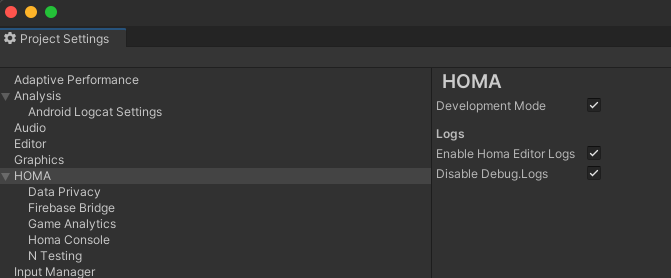Homa Belly Settings
Homa Belly SDK uses Unity’s Project Settings. You can open the Project Settings window using the application menu. Settings from the different Homa Belly packages will be under the HOMA section.
Main settings
The main settings are under the HOMA Settings.

Development Mode
Homa Belly’s development mode will change quite a few things:
- It will enable extra runtime logging from the SDK,
- It will set the 3rd party SDK managed by Homa Belly (for example GameAnalytics) to development mode,
- It will enable event validation in Homa Analytics,
- It will enable Homa Console in device builds,
- It will disable Adjust signature.
This setting is a debugging tool. It will cause slower runtime, and builds with this setting enabled may cause security issues if pushed to the store.
Caution
DO NOT push a build with this setting enabled to the App Store or the Play Store.
Enable Homa Editor Logs
This setting controls some logs issues by Homa Belly’s editor scripts, starting with the [HOMA] tag. This does not affect all scripts, and this does not affect play mode either.
We are currently working on a better logging solution, the give you more control over what Homa Belly logs.
Disable Debug Logs
This setting will disable all calls to the Debug class in the project, to improve performance in context where logs are not needed (like a release build).
More specifically, this setting will enable a class called Debug defined in the global namespace. This class will be used instead of the regular UnityEngine.Debug class for the whole project, and “intercept” debug log calls. Most of the method in this class have the ConditionalAttribute, meaning the calls will be ignored as compile time, effectively nullifying debug logs.
Note: This option will not work if you put your using statements inside your namespace. For more information on how using inside namespaces work, see this Stack Overflow post.
Privacy
The settings for Privacy can be found under HOMA/Privacy. For more information about the Privacy service, see the privacy module documentation.
Enable Privacy service
Use this toggle to enable/disable the privacy service in your builds. When disabled, all consent kinds will be considered Granted, no popup will be shown at the start of the game, and RegionRequiresConsentManagement will always return false.
App Tracking Transparency (ATT) Popup Message
The text you put here is the one that is going to be shown on the App Tracking Transparency (ATT) popup. The ATT popup only shows on iOS.
ATT popup timing
Lets you control when the App Tracking Transparency (ATT) popup is shown, either before or after AdsTailoring consent (i.e. the GDPR consent screen). Changing this value may lead to Apple rejecting your app update.
See the “Asking permission to track” section of this page for more information on the ATT popup.
Show ATT popup if consent was declined
Lets you control if the App Tracking Transparency (ATT) popup should be shown if the AdsTailoring consent kind (GDPR) was declined. This option is only applicable if the ATT popup timing is set to "after AdsTailoring consent". Changing this value may lead to Apple rejecting your app update.
Firebase
Note
These settings are only available if you have the Homa Belly Firebase package in your project.
The settings for the Firebase package can be found under HOMA/Firebase Bridge.
Enable Default Crashlytics User Properties
Crashlytics lets you add custom keys to help identify the state of the app when a crash occurs. Enabling this option will let Homa Belly add pre-defined keys automatically to Crashlytics. Those keys include:
Current Levelaccording to the data you send to AnalyticsCurrent Active Scenewith the path of the current active sceneCurrent Scene Listwith the list of the currently loaded scenesLast network namefor the name of the last ad network that shown an ad to the user. This may be useful to identify crashes caused by one specific ad network.Current full screen ad typewith the type of full screen ad currently shown, if any
See this documentation page on Crashlytics Keys for more information.
GameAnalytics
The settings for the GameAnalytics package can be found under HOMA/Game Analytics.
Disable CD Integration
N-Testing automatically sets GameAnalytics’ custom dimensions. This is done to match data between GameAnalytics and N-Testing. If you are using the custom dimensions yourself, and do not want N-Testing to set its value, you can enable this option.
Dimensions manually set
N-Testing, when setting GameAnalytics’ custom dimensions, will not override dimensions that would have been already set. If it detects previously set dimensions, it will set this toggle to true to notify you. If the toggle is true while you do not expect it to, you can click the “Clear manually set dimensions” button.
Homa Console
The settings for the Homa Console package can be found under HOMA/Homa Console.
Activator Mode
This setting lets you choose where the button to open the Homa Console will be on the screen. You will have to click this button multiple times to open the console. This option is useful if you have buttons in your game you want to access that would be below the console button.
Note: The console will only be available if the Development Mode is enabled.
Activator Size
This option controls the size of the button to open the Homa Console.
N-Testing
The settings for N-Testing can be found under HOMA/N Testing.
DVR Script Version
This option lets you control how the DVR class is generated:
- In the first version (deprecated), the fields of the DVR class are of the type of the variable (like
string,booletc.). There is no way for you to know if or when the value is updated. - In the second version, fields are of type
Observable<T>. With this, you can know when the DVR values are updated. This is especially useful when using segmentation.
Important
The first version is deprecated, and you should only use this option for backward compatibility
DVR Script
This field shows you the generated DVR script, that holds all the DVR values.
There is also a button to re-generate this script. Re-generating it has 2 effects:
- It will add the new fields that have been added to Homa Lab,
- It will also refresh the default values for the next builds. This is because the default values are stored in the generated file. We are planning on moving those values somewhere else, to be able to update them more frequently automatically.
Homa Splash Screen
Note
These settings are only available if you have the Homa Splash Screen package in your project.
The settings for the DataPrivacy package can be found under HOMA/Splash Screen.
This settings page lets add your logo to the Homa Splash screen, as well as customising the way it appears. We won’t go through all the settings available here, but you can:
- Change the scene loading behavior, both in editor and in builds,
- Change your company logo, as well as its size and color.
